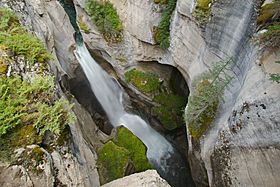Maligne Canyon facts for kids
Quick facts for kids Maligne Canyon |
|
|---|---|

Looking down into Maligne Canyon
|
|
| Location | Jasper National Park, Alberta |
| Coordinates | 52°55′13″N 118°0′39″W / 52.92028°N 118.01083°W |
| Width | 2 metres (6.6 ft) |
| Depth | 50 metres (160 ft) |
| Formed by | Maligne River |
| Geology | Palliser Formation |
Maligne Canyon is a super cool and deep slot canyon located in the Jasper National Park in Alberta, Canada. It was carved out by the Maligne River from a type of rock called the Palliser Formation. This amazing canyon is more than 50 metres (160 ft) deep! It's a popular spot for visitors to explore. You can see beautiful waterfalls, hidden underground streams, and lots of birds and plants here.
How Maligne Canyon Was Formed
Slot canyons like Maligne Canyon are quite common in the northern Rocky Mountains. They form in areas with a special kind of ground called Karst topography. This means the ground has rocks that dissolve easily, like limestone.
The Maligne River's Journey
The Maligne River starts from Medicine Lake. For about 15 kilometers (9 miles) upstream, it flows like a normal river. But then, it becomes a "losing stream." This means the river water quickly disappears into cracks and holes in the ground. For most of the year, the river completely vanishes from the surface not far from the lake.
Smaller streams feed the valley below that point. These streams help rebuild the river by the time it reaches the top of the canyon. The river then drops down into the canyon. Here, it meets the bedrock layers where the underground river flows. Many large underground streams also join here, making the river flow much stronger.
Erosion and Canyon Features
The canyon is always being shaped by the water. The churning and swirling of the river slowly wears away the rock. This constant erosion has made the canyon very narrow. At some points, it's only 2 metres (6.6 ft) wide! The canyon is also very deep, reaching 50 metres (160 ft) in some places.
The main type of rock found in the canyon is Limestone. This rock was formed a long, long time ago. It came from tiny ocean creatures called plankton that lived in a shallow tropical sea. When these creatures died, their shells settled on the seafloor and eventually turned into limestone.

